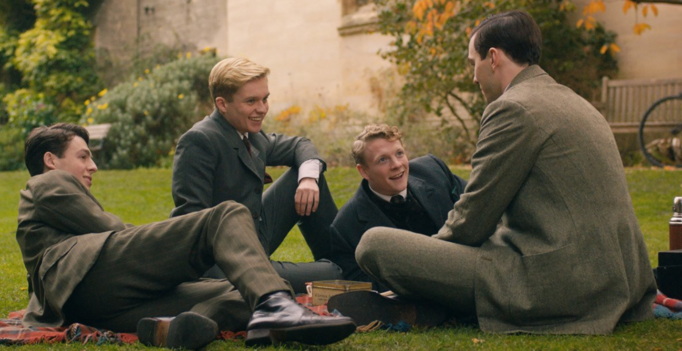By: Jolie Featherstone
Dome Karukoski’s Tolkien is a polished, but reserved, Edwardian period piece that explores the early life of J. R. R. Tolkien, famed author of The Lord of the Rings. From a childhood fraught with loss to serving in in the First World War as a young adult, the film draws connections between Tolkien’s real-life experiences and the lore and legends he created in his works.
The film shines a light on Tolkien’s close friend circle, the beginning of his academic career, and his relationship with his wife Edith Bratt (played by Lily Collins in a charming, if underutilized, performance). His merry band of chosen brothers, or fellowship as it were, become close as they grow up and weather love and loss together, including the outbreak of WWI which threatens to tear their fellowship, and indeed life as they know it, apart. In a style reminiscent of Dead Poets Society and The Emperor’s Club, the film casts a loving and nostalgic eye on the close friendships of these collegiate young men eager to leave their mark on the world.
Beautifully-drawn and demure, Karukoski’s respect for Tolkien is readily apparent. The film does not dive too deeply into Tolkien’s inner life. This is an interesting choice considering the depth of J. R. R. Tolkien’s creations and his openly-shared socio-political and religious views. The film remains reverent, safe – perhaps to its detriment.
Karukoski admirably takes a creative approach to adapting Tolkien’s life for the screen by imbuing fantastical flourishes throughout to illustrate the author’s powerful imagination. Tolkien’s life-long love, Edith, dancing in the sunlight becomes an ethereal Elven princess. The horrors on the battlefield and in the trenches of WWI manifest as wraiths, and monsters. Although these magical elements are gorgeously rendered, the transition between buttoned-down bildungsroman and whimsical re-imagination are not always smooth. At times the pieces fit beautifully together. At other times the divergence is noticeable, making the viewer aware of their own recalibration.
Nicholas Hoult, one of the most promising actors of his generation, delivers a sturdy performance in the title role and, in doing so, demonstrates his prowess in a classic leading man role. The scenes depicting the intimate conversations between Tolkien and his close friends are among the most delightful scenes in the film. Anthony Boyle delivers a sensitive portrayal of Tolkien’s close friend, Geoffrey Smith. One scene in particular, wherein Smith comforts Tolkien in a moment of tumultuous abandon, is a memorable moment of compassion and support between two young men that is not often portrayed on the screen.
Unsurprisingly, the Tolkien Estate has disavowed the film. Die-hard Tolkien fans should approach the film as an affectionate exploration of Tolkien’s formative years, not as a hard-hitting review of his life. Tolkien is a beautiful, imaginative depiction of a man who became immortalized by inspiring the world through words.
**********
Do You Tweet? Follow These Tweeple:
Jolie Featherstone: @TOFilmFiles




Leave a comment